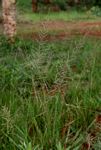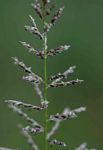| Home | > | List of families | > | Poaceae | > | Sporobolus | > | pyramidalis |
Sporobolus pyramidalis
Selected images: Click on each image to see a larger version and details of the record View all images (2)
Detailed records: Display species records QDS maps by: Google Maps Point records by Google Maps
Species details: Click on each item to see an explanation of that item (Note: opens a new window)
| Synonyms: |
Sporobolus indicus var. pyramidalis (P. Beauv.) Peter Sporobolus rueppellianus Fresen. Vilfa pyramidalis (P. Beauv.) Steud. Vilfa rueppelliana (Fresen.) Steud. |
| Common names: | Catstail dropseed (English) Narrow-plumed dropseed (English) |
| Frequency: | |
| Status: | |
| Description: |
Coarse tufted perennial grass with a strong root-system and unbranched culms, up to 2 m tall, 2–5 mm in diameter at the base (sometimes less), erect, unbranched; basal leaf sheaths chartaceous, glabrous, slightly compressed to strongly keeled, persistent; leaf laminas up to 50 cm × 3–10 mm, flat (folded on drying), smooth and glabrous on the surfaces and margins, tapering to a flexuous filiform apex. Inflorescence an open panicle of pyramidal shape, 20–45 cm long; inflorescence branches not whorled, spreading horizontally at anthesis, the longest 5–10 cm long, scaberulous, eglandular, subsecund, the spikelets densely (sometimes rather loosely) arranged along their whole length, sometimes on short secondary branchlets. Spikelets very small, (1.4)1.7–2(2.3) mm long, grey to purple; inferior glume 1/5–1/3 the length of the spikelet, broadly oblong, hyaline, nerveless, glabrous, obtuse to truncate at the apex, sometimes irregularly toothed or erose; superior glume 1/3–1/2(3/5) the length of the spikelet, broadly oblong to broadly ovate or even oblate, hyaline, 1-nerved, scaberulous on the nerve, broadly obtuse to truncate at the apex, often apiculate, sometimes ± 3-lobed, irregularly toothed or erose; lemma as long as the spikelet, ovate-elliptic, acute at the apex; anthers 3, 0.6–1.1 mm long. Grain 0.8–1 mm long, obovate, conspicuously truncate, laterally compressed and oblong in section. |
| Notes: | |
| Derivation of specific name: | pyramidalis: pyramidal (referring to the inflorescence) |
| Habitat: | Widely distributed, in dambo and floodplain grassland, on streambanks and in estuarine mud, less often in open woodland and montane grassland; it is common where soil fertility is high and is a weed of permanent and planted pasture; it is invasive in over |
| Altitude range: | Up to 2290 m |
| Flowering time: | Nov - May |
| Worldwide distribution: | Widespread in tropical Africa, also in South Africa, Yemen, Madagascar and Mauritius and introduced elsewhere (e.g. South America) |
| Malawi distribution: | N,C,S |
| Growth form(s): | |
| Endemic status: | |
| Red data list status: | |
| Insects associated with this species: | |
| Spot characters: | Display spot characters for this species |
| Literature: |
Burrows, J.E. & Willis, C.K. (eds) (2005). Plants of the Nyika Plateau Southern African Botanical Diversity Network Report No. 31 SABONET, Pretoria Page 365. Chapano, C. & Mamuto, M. (2003). Plants of the Chimanimani District National Herbarium and Botanic Garden, Zimbabwe Page 52. Chapano, C. & Mugarisanwa, N.H. (2003). Plants of the Matobo District National Herbarium and Botanic Garden, Zimbabwe Page 34. Cope, T.A. (1999). Poaceae Flora Zambesiaca 10(2) Pages 184 - 186. (Includes a picture). Heath, A. & Heath, R. (2009). Field Guide to the Plants of Northern Botswana including the Okavango Delta Kew Publishing Page 501. (Includes a picture). Jackson, G. & Wiehe, P.O. (1958). An Annotated Check List of Nyasaland Grasses The Government Printer, Zomba, Nyasaland Page 61. Mapaura, A. & Timberlake, J. (eds) (2004). A checklist of Zimbabwean vascular plants Southern African Botanical Diversity Network Report No. 33 Sabonet, Pretoria and Harare Page 110. Roodt, V. (2015). Grasses & Grazers of Botswana and the surrounding savanna Struik Nature, South Africa Pages 196 - 197. (Includes a picture). Setshogo, M.P. (2005). Preliminary checklist of the plants of Botswana. Sabonet Report no. 37. Sabonet, Pretoria and Gaborone Page 146. Timberlake, J.R. & Childes, S.L. (2004). Biodiversity of the Four Corners Area: Technical Reviews Volume Two (Chapter 5-15) Appendix 5-1: Plant Checklist Occasional Publications in Biodiversity 15 Page 192. Wursten, B., Timberlake, J. & Darbyshire, I. (2017). The Chimanimani Mountains: an updated checklist. Kirkia 19(1) Page 86. |
Other sources of information about Sporobolus pyramidalis:
Our websites:
Flora of Botswana: Sporobolus pyramidalisFlora of Caprivi: Sporobolus pyramidalis
Flora of Caprivi: cultivated Sporobolus pyramidalis
Flora of Mozambique: Sporobolus pyramidalis
Flora of Zambia: Sporobolus pyramidalis
Flora of Zimbabwe: Sporobolus pyramidalis
External websites:
African Plants: A Photo Guide (Senckenberg): Sporobolus pyramidalisAfrican Plant Database: Sporobolus pyramidalis
BHL (Biodiversity Heritage Library): Sporobolus pyramidalis
EOL (Encyclopedia of Life): Sporobolus pyramidalis
GBIF (Global Biodiversity Information Facility): Sporobolus pyramidalis
Google: Web - Images - Scholar
iNaturalist: Sporobolus pyramidalis
IPNI (International Plant Names Index): Sporobolus pyramidalis
JSTOR Plant Science: Sporobolus pyramidalis
Mansfeld World Database of Agricultural and Horticultural Crops: Sporobolus pyramidalis
Plants of the World Online: Sporobolus pyramidalis
Tropicos: Sporobolus pyramidalis
Wikipedia: Sporobolus pyramidalis
| Home | > | List of families | > | Poaceae | > | Sporobolus | > | pyramidalis |

